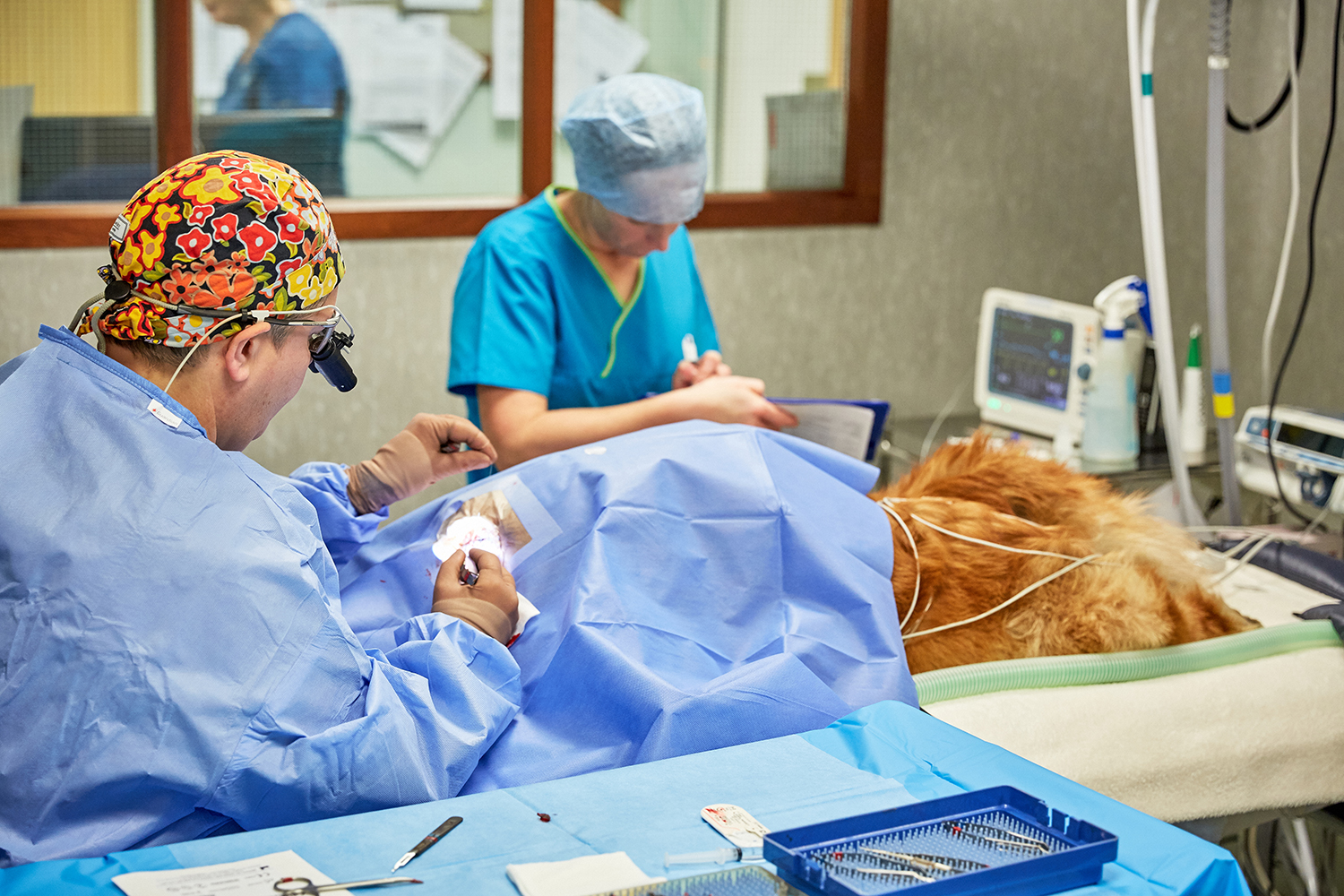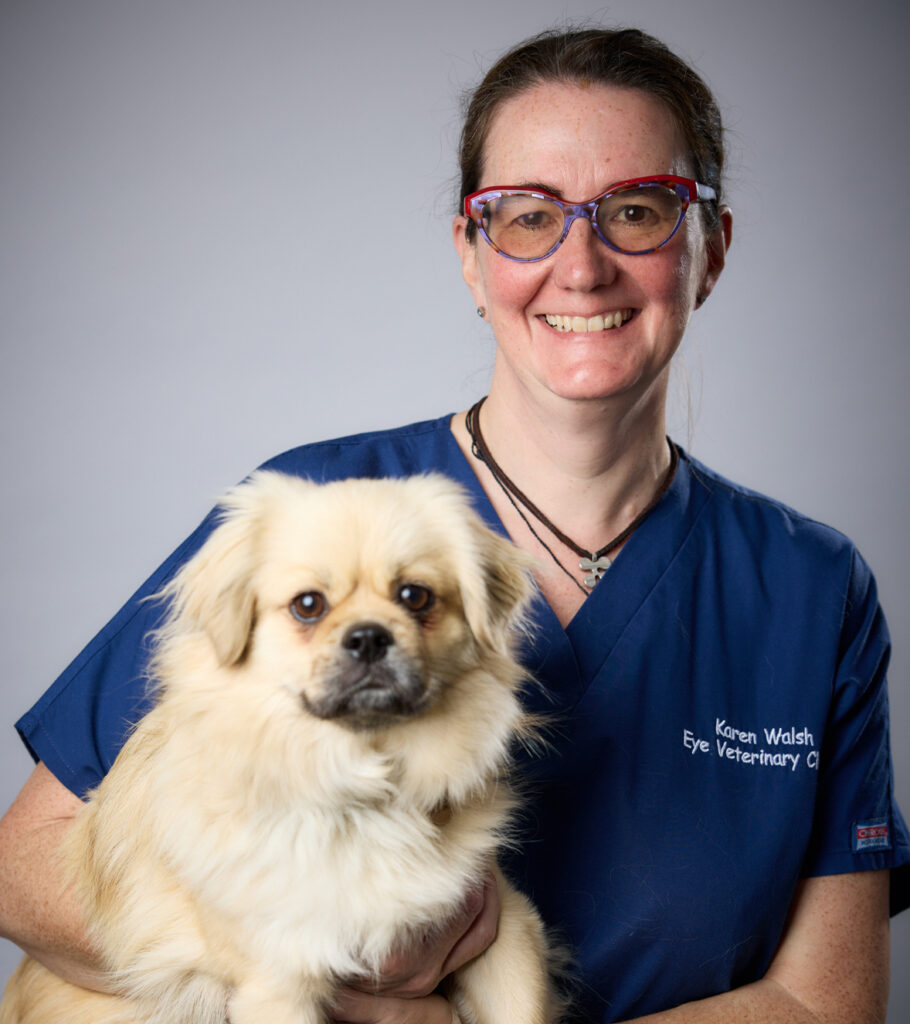
Anaesthesia at Eye Vet Clinic
We are delighted to have a specialist in veterinary anaesthesia and pain management working as one of the owners and directors here at Eye Vet Clinic.
Karen oversees our experienced team of veterinary nurses and interns to ensure that our patients receive the highest standard of care and safety for their anaesthetics. Karen also reviews our protocols for pain relief and makes sure that we can offer tailored treatment for each case. This way, staff and clients can have peace of mind!

General anaesthesia (GA)
What is a general anaesthetic?
Anaesthesia removes our awareness of our surroundings by producing a reversible unconsciousness. We can produce (induce) anaesthesia using several methods but the most common is an injection into the vein. This is often followed by administration of a gas via the lungs. These drugs stop the transfer of messages from the body to the brain, allowing our patients to be still during surgery. As part of general anaesthesia, we will also give your pets drugs to make them as pain free as possible.
Does my pet really need an anaesthetic?
Unlike humans, we cannot ask our patients to place themselves in the positions required for procedures such as cataract surgery, this means that we will need to anaesthetise or sedate our patients more frequently than you need to be for a similar procedure. Unfortunately, even if we use local anaesthetics this may remove the pain but will not help to keep your pet still while the procedure is performed.
What do I need to do to prepare my pet for surgery?
- You will need to fast (starve) your pet for 6-8 hours – your pet should have their normal meal the night before admission (unless otherwise instructed) but should have no further access to food after this, sometimes we may ask you to give a meal very early in the morning depending on their disease and the timing of their procedure.
- He or she should have free access to water until you leave the house to come to the surgery.
- If your pet is younger than 6 months old or is suffering from diabetes, then please discuss with one of the nurses how long you should withhold food for.
- Cats should be kept in the night before the procedure to prevent them helping themselves to food from elsewhere and to make it easy to find them in the morning!
- Take your dog for a walk in the morning to allow him or her to empty the bladder and bowels.
- Watch out for any signs of illness not related to the procedure which is about to be carried out on your pet, and let the vet or nurse know if you have any concerns.
- Have a note of your pet’s current medication, including over-the-counter preparations, and make sure that the vet or nurse knows about these at the time of admission. It may be easier to bring them all with you, so you do not forget about any of them.
After my pet is admitted, what happens next?
Each patient has an individual anaesthetic protocol tailored to them depending on their medical conditions, the procedure they are about to have and their temperament. Most patients will receive a ‘pre-med’ this will help to calm them so that we can place an intravenous catheter. This will allow us to administer further drugs and intravenous fluids throughout the procedure. Most pets will be given an intravenous injection of anaesthetic which will allow us to place a tube down their windpipe, enabling us to give oxygen and anaesthetic gases. Some pets may have a sore throat after the anaesthetic because of the tube.
I’m really worried about my pet having an anaesthetic…
As with most things, we cannot eliminate all risk associated with anaesthesia. Our aim is to treat each patient as an individual and monitor them from the moment they receive any anaesthetic drugs right through to recovery. We have qualified nurses that will monitor your pet during anaesthesia and they will discuss any issues during the procedure with either an anaesthetist or the vet in charge.
Anaesthesia is often safer than sedation because we can administer 100% oxygen and are able to monitor your pet more closely. Our routine monitoring includes:
- A dedicated nurse for each pet
- Pulse and heart rate
- Respiratory rate
- Temperature
- Blood pressure
- ECG
- Capnography (Carbon dioxide in the blood)
- Level of oxygen in the blood (SpO2)
- Muscle activity (if we use paralysing drugs)
The nurse in charge will take readings every 5 minutes during the surgery and then slightly less frequently when your pet is in recovery. All this information is important, and it helps us to anticipate potentially significant problems almost before they occur. If there are any concerns, we can adjust the level of anaesthesia if required.
During recovery, your pet will be taken to a warm and comfortable bed in the recovery area and will be carefully monitored until he or she is fully awake.
Do you give my pet pain killers?
In most cases your pet will receive at least two types of pain killers. We will usually give a morphine type drug in the ‘premed’ and an administer an anti-inflammatory. It is important to tell us if your pet has had any side-effects from any of these types of drugs before. In some cases, your pet may have local anaesthesia during the procedure. It is very likely that your pet will go home with anti-inflammatory pain killers.
Will they be unwell when they come home?
Often your pet is discharged on the day of surgery. He or she may be a little sleepy, this may be the after effects of the anaesthetic, the stress of being away from home and some of the pain killers they may have received. Ideally you should offer a light meal, but don’t worry if they are not hungry. If there are symptoms that worry you or appear to get worse, please contact us or your own vet.
How can I look after my pet at home?
-
- A cosy, quiet bed where you can observe them
- Keep cats in until the next day
- Dogs can have a short lead walk to allow toileting but do not let them off the lead
Please consult your discharge instructions for specific medication and care
Sedation
What is a sedation?
Sedation is when drugs are administered to produce a state of calm or sleep. Some of the effects of the drugs can ‘reversed’ after the procedure is finished to speed up recovery. We will usually place a cannula in the vein in one of their legs so the drugs can be given, so there will be a small clipped patch. We may also administer oxygen via a face mask if required.
Monitoring your pet during sedation
We monitor your pet in a similar way to during anaesthesia. The most important one being a nurse assigned to their care throughout the procedure. We will also monitor the level of oxygen in their blood.
When do you choose sedation over general anaesthesia?
In general, we will use sedation for short procedures. If we are worried that your pet has lung or heart problems we may opt to perform general anaesthesia. This may seem strange but often anaesthesia gives us much more control over you pet’s oxygen levels which is vitally important. Also, some of the drugs used during sedation can last as long or even longer than the effects of general anaesthesia.
How do I prepare my pet for a sedation?
As with general anaesthesia it is ideal if they have a period of fasting (approximately 6 hours) before we administer the sedation drugs. Give your pet access to water until your appointment.
Please let the vet or nurse know if your pet is taking any medication, you can always bring them with you, so you don’t forget what they are!
As with general anaesthesia it is helpful if you take dogs for a walk before the sedation to empty their bowels and bladder.
What do I do when I take my pet home?
- Keep cats in until the next day
- Only walk your dog on the lead for that day
- Give them a warm bed and access to water
- Offer them a light meal in the evening but don’t worry too much if they don’t eat
- Monitor them for signs of discomfort and any other problems